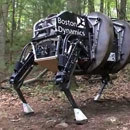3 Science Fictions We Really Just Built

Science fiction authors are desperately racing to stay ahead of the rampaging creations of real science, or at least wishing they'd thought of that plot. You'd swear scientists were trying to keep up the average IQ by canceling out every episode of reality TV with a brand new invention. And they're winning. These are just a few of the incredible things we've completed, discovered or "laughed maniacally while throwing the huge sparking ON switch" of in the last month.
Laser Blasting Another World
Star Trek had a machine which could vaporize rock, another which could measure anything and real rocket scientists sneered "inefficient." NASA got a phaser and a tricorder drunk and welded the result onto a mast on an interplanetary atomic sciencetank. The Curiosity Rover's ChemCam amplifies the idea "looking at things" so hard that the thing is no longer there. Because it looks Cyclops-style with dozens of million watt laser blasts, then works out what used to be there by analyzing the glow of the vaporized ex-something. And we fired it on Mars.

Robot graffiti is impossible to remove
It combines a camera with a laser to shoot whatever is being recorded. If YouTube used that technology we'd improve the human race within a week. It's also why we put it on the mast of our ambassador robots -- it's way scarier than a Skull and Crossbones and kicks much more ass. If you think you can't have pirates on Mars because there was no water, Curiosity also found evidence that there was running water. We are right now driving an exoplanatery robot along the stream bed of one of the most exciting clues about life on another planet and the possible fate of our own. If you're into that kind of thing.
Worked Out How to Kill Optimism With Magnets
Science gives us reasons to be optimistic about this world, because science gives us everything in this world, including a way to fix that "optimism" bug. The human brain has a serious design flaw, over-valuing positive information and minimizing bad news. That's because any monkey who could truly appreciate the nature of saber-toothed tigers and how a fight with one ends would never have climbed down from the trees in the first place. But this has left us with people who continue to invest in financial bubbles, ignore serious medical advice and continue to buy lottery tickets while hoping that burning smell from under the car hood will just go away.

"Score, the burning insulation covers the stink of all this tequila!"
University College London has worked out how to destroy optimism with transcranial magnetic manipulation. Normally you have to annoy Ming the Merciless to hear a sentence like that. They target the left inferior frontal gyrus (IFG) of the brain. That's how smart these people are: They're drawing crosshairs on parts of your brain it didn't even know it had. By inducing currents in the participants' living brains, those brains became better at updating their expectations when faced with bad news. News like "the machines are now inducing currents in your living brain."

"I guess I like the Matrix movies, why do you ask?"
Zapping the left IFG made people more realistic, while blasting the right sent the brain from rose-tinted glasses to an entire romantic garden in a scuba mask. They point out how electromagnetically modifying this bias could avoid problems like the global financial meltdown, improve civilization's preparation for natural disasters, and end optimism. So if you've ever wondered what a megavillain's good intentions origin story looked like, this paper is it.
The Cheetah Robot and AlphaDog

Boston Dynamics released video footage of their Cheetah Robot to YouTube, titled "Cheetah Robot runs 28.3 mph; a bit faster than Usain Bolt." I try to avoid "robots vs. humanity" jokes, but robot combat is one thing I won't be able to avoid when companies are deliberately pointing out how their military prototypes are swifter than our fastest humans. They claim it can't walk in the wild yet, but we're not sure if that's technical limitations or because they're worried that they'd never be able to catch it.
Also, they've just demonstrated a robot which can walk in the wild. And by "walk" we mean "stalk us." The AlphaDog has been big news with people who want to know when they personally become obsolete for a long time. This month Boston Dynamics fitted it with the ability to track humans and then released into a forest with a human target as they filmed it -- presumably in an attempt to kick the shit out of the Blair Witch Project.
It can only track humans holding a touch-screen mobile device, but that just shows that the machines now understand our weaknesses. If survival means throwing away your smartphone, most modern people would choose to spend their last moments in the company of two machines instead. They've also designed a system more guaranteed to go rogue than a fighter jet in a lightning storm being asked about the meaning of love. The AlphaDog is designed to carry heavy loads, but the "handheld" control panel weighs over 4 kilograms. Normally the first dead-meat in a movie gives the robot autonomy out of greed or hatred -- the AlphaDog will gain access to its own controls through sheer human laziness.